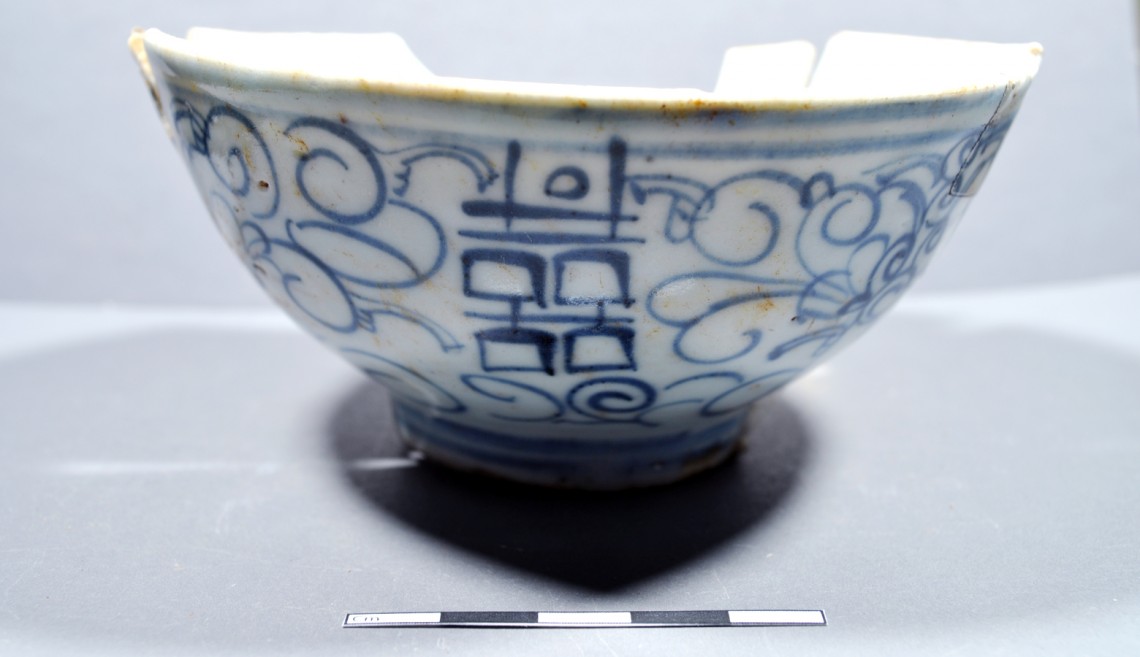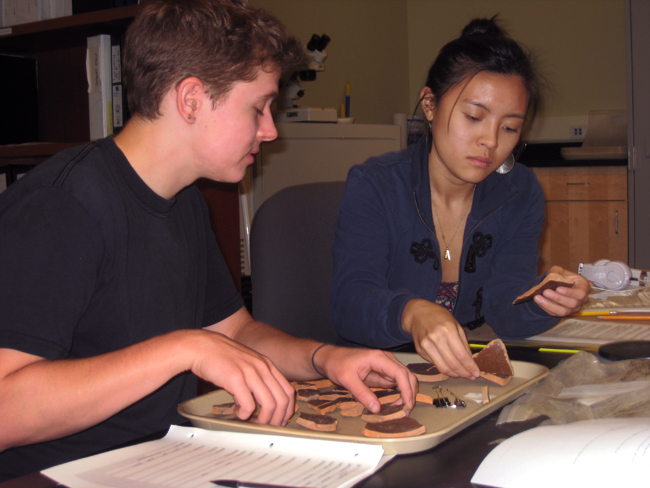
A partial 'double happiness bowl'
Courtesy of Market Street Chinatown Archaeology Project.Stanford anthropology team prepares fractured, historic objects for art gallery debut
Stanford students work with San Jose Institute of Contemporary Art staff and artist Rene Yung to reframe the mundane objects from Market Street Chinatown in the exhibition City Beneath The City.
Stanford students taking Barbara Voss’ anthropology classes have been sifting through San Jose’s 19th century Market Street Chinatown remains for years, but the thousands of artifacts that have been excavated have never been on view to the public, until now.
A selection of 60 artifacts has been assembled to create City Beneath The City at the San Jose Institute of Contemporary Art (ICA) in downtown San Jose. The exhibition will remain on view through Sept. 16 and is included in the ZERO1 Biennial, North America’s most significant showcase of contemporary work at the nexus of art and technology.
Among the objects of everyday life are a favorite pipe, a hair comb and the leg from a love-worn china doll.
Ten years ago Voss, an associate professor of anthropology, was approached by History San José and the Chinese Historical and Cultural Project to help make the artifacts from the Market Street Chinatown dig accessible to the public.
Each of these simple, humble objects of daily life is a nexus of these layered connections.
The product of three years of excavation work done under Fairmont Hotel from 1985-1988 was sitting in boxes gathering new dust and waiting to be unearthed, yet again. So, in 2002 Voss and her students dug into the boxes and over the years have cataloged more than 4,000 objects.
City Beneath The City is the first public display of objects excavated from San Jose’s historic Market Street Chinatown site and is one way that the artifacts are getting out of the boxes and into the spotlight.
A hybrid exhibition
The Stanford University-ICA collaboration came about because the 2012 ZERO1 Biennial theme is “Seeking Silicon Valley.” Organizers state that the biennial proposes that contemporary art practice can re-imagine the idea, the place and the experience of Silicon Valley. Using Silicon Valley as a physical and virtual backdrop, the ZERO1 Biennial will transform a region synonymous with technology into a publicly accessible network of activity, exploration and provocation.

Courtesy of Market Street Chinatown Archaeology Project.
Last fall ICA curator Susan O’Malley, a Stanford grad, contacted Voss, who was offering Anthro 112/212 ‘Public Archaeology: Market Street Chinatown Archaeology Project’ about a possible collaboration in conjunction with ZERO1. Voss and O’Malley started talking about a joint project and commissioned artist Rene Yung, another Stanford alum, to create an archaeology/contemporary-art hybrid exhibition for the ICA. “Rene is able to see and visually interpret stories of everyday, mundane objects that archaeologists and anthropologists might not see,” said Voss.
An immigrant from Hong Kong, Yung brings a deep understanding of cross-cultural dynamics to her national work with diverse communities. As an installation artist and interdisciplinary systems thinker, Yung was able to edit the Chinatown collection down to its essence and with a few simple objects suggest home, family, tradition and loss.
“I want this installation to speak of the multiple realities that coexist in this fragile collection: cultural, historical, political, geographic, personal,” said Yung. “Each of these simple, humble objects of daily life is a nexus of these layered connections. As visitors navigate through the installation, I hope they will make their personal connections – refracted through their own sets of realities – between these different spaces, and come to an insight or two that link the forgotten lives of Market Street Chinatown to their present lives and our present time.”
“In response to the ZERO1 art and technology biennial thematic Seeking Silicon Valley, City Beneath The City exposes a history of the valley before it was dubbed Silicon Valley,” explained O’Malley. “Whereas Silicon Valley is obsessed with the next technology that will revolutionize our lives, this project will look to the past in order to understand the significance of Silicon Valley today.”
City Beneath The City seeks to elicit an emotional response, drawing on viewers’ memories and assumptions about what domestic, fractured and historic objects may represent in the context of a contemporary art space. Through supporting materials including maps, photography and wall labels, a surprising narrative of a once-thriving Chinatown in downtown San Jose unfolds for the viewer.
By presenting this installation in a contemporary art space and within the context of ZER01, the project team hopes to inspire dialogue on issues ranging from immigration policies, labor and minority struggles to land and urban development.
Former student and now collections manager for the Chinatown archaeology project, Megan Kane, ’07, MA ’08, said, “For me, the most exciting part of the Market Street Chinatown archaeology project as a whole is the fact that more than 25 years later we are still learning from this collection of artifacts, and with the opening of the City Beneath the City exhibit, we are still touched by these objects and the community they represent.”
A service-learning course, Anthro 112 received a course development grant and other resources from Stanford’s Haas Center for Public Service.
Silicon Valley history lesson
At the height of its existence, the Market Street Chinatown, located at the intersections of Market and San Fernando streets in downtown San Jose (a 10-minute walk from the ICA), was the largest Chinese community anywhere in the United States outside of San Francisco. It flourished both economically and culturally from the 1860s until it was destroyed in an arson fire in 1887.
Whereas Silicon Valley is obsessed with the next technology that will revolutionize our lives, this project will look to the past in order to understand the significance of Silicon Valley today.
Nearly a century later, the site of Market Street Chinatown was redeveloped to build the Fairmont Hotel and the Silicon Valley Financial Center. Archeologists unearthed what was left at the location only to discover one of the most important excavation sites of overseas Chinese materials in the United States at the time.
Along with Bay Area successes are stories of class struggle and racial bias that are often excluded from the mainstream narrative. In presenting artifacts from the Market Street Chinatown, City Beneath The City will provide a space to reflect on the past – including the remarkable lives and struggles of those early settlers and laborers – in order to imagine future possibilities for the region.
The San Jose Institute of Contemporary Art at 560 S. First St. is open Tuesday-Friday, 10 a.m.-5 p.m., and Saturday, noon-5 p.m. Admission is free.
ZERO1 Biennial is presented throughout Silicon Valley and the greater Bay Area. Opening events take place Sept. 12-16 with exhibitions, public art and programs extending through mid-December.
